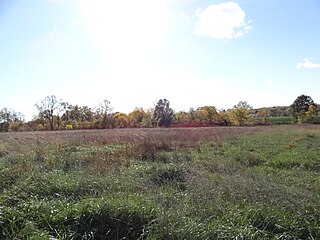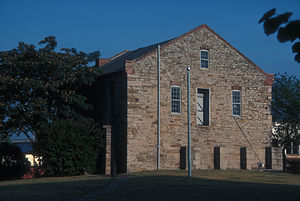
Richard Montgomery Gano was a physician, Protestant minister, and brigadier general in the army of the Confederate States during the American Civil War.

The Battle of Marais des Cygnes took place on October 25, 1864, in Linn County, Kansas, during Price's Missouri Campaign during the American Civil War. It is also known as the Battle of Trading Post. In late 1864, Confederate Major-General Sterling Price invaded the state of Missouri with a cavalry force, attempting to draw Union troops away from the primary theaters of fighting further east. After several victories early in the campaign, Price's Confederate troops were defeated at the Battle of Westport on October 23 near Kansas City, Missouri. The Confederates then withdrew into Kansas, camping along the banks of the Marais des Cygnes River on the night of October 24. Union cavalry pursuers under Brigadier General John B. Sanborn skirmished with Price's rearguard that night, but disengaged without participating in heavy combat.
The Army of the Frontier was a Union army that served in the Trans-Mississippi Theater during the Civil War. It fought in several minor engagements in Arkansas, Indian Territory, and Kansas. In June 1863 the Army was discontinued but many of its regiments were formed into the District of the Frontier.

Price's Missouri Expedition, also known as Price's Raid or Price's Missouri Raid, was an unsuccessful Confederate cavalry raid through Arkansas, Missouri, and Kansas in the Trans-Mississippi Theater of the American Civil War. Led by Confederate Major General Sterling Price, the campaign aimed to recapture Missouri and renew the Confederate initiative in the larger conflict.
The Battle of Poison Spring was fought in Ouachita County, Arkansas on April 18, 1864, as part of the Camden Expedition, during the American Civil War. A Union force commanded by Major General Frederick Steele had moved from Little Rock, Arkansas towards Shreveport, Louisiana in support of Major-General Nathaniel Banks' move up the Red River towards Shreveport. After Banks was defeated at the battles of Mansfield and Pleasant Hill, Steele was isolated in Arkansas. Short on supplies, Steele sent a detachment commanded by Colonel James M. Williams to search for supplies. Williams' column was attacked by Confederate troops under the command of Brigadiers General John S. Marmaduke and Samuel B. Maxey. After a sharp fight, Williams' command was routed, losing its wagon train and four cannons. The defeat at Poison Spring and another defeat at the Battle of Marks' Mills a week later led Steele to retreat to Little Rock. The battle is infamous for the Confederates' slaughter and mutilation of African-American Union soldiers of the 1st Kansas Colored Infantry. Poison Springs Battleground State Park, which is part of the Camden Expedition Sites National Historic Landmark, preserves a portion of the site of the battle.

The Battle of Honey Springs, also known as the Affair at Elk Creek, on July 17, 1863, was an American Civil War engagement and an important victory for Union forces in their efforts to gain control of the Indian Territory. It was the largest confrontation between Union and Confederate forces in the area that would eventually become Oklahoma. The engagement was also unique in the fact that white soldiers were the minority in both fighting forces. Native Americans made up a significant portion of each of the opposing armies and the Union force contained African-American units.
The Battle of Old Fort Wayne, also known as Maysville, Beattie's Prairie, or Beaty's Prairie, was an American Civil War battle on October 22, 1862, in Delaware County in what is now eastern Oklahoma.

The 1st Cherokee Mounted Rifles was a Confederate States Army regiment which fought in the Indian Territory during the American Civil War. It was formed from the merger of two predecessor units the First Regiment of Cherokee Mounted Rifles, and the Second Regiment of Cherokee Mounted Rifles. The first commander was Col. John Drew, while the second was Stand Watie.

During the American Civil War, most of what is now the U.S. state of Oklahoma was designated as the Indian Territory. It served as an unorganized region that had been set aside specifically for Native American tribes and was occupied mostly by tribes which had been removed from their ancestral lands in the Southeastern United States following the Indian Removal Act of 1830. As part of the Trans-Mississippi Theater, the Indian Territory was the scene of numerous skirmishes and seven officially recognized battles involving both Native American units allied with the Confederate States of America and Native Americans loyal to the United States government, as well as other Union and Confederate troops.
The Department of Kansas was a Union Army command department in the Trans-Mississippi Theater during the American Civil War. This department existed in three different forms during the war.
The Battle of Massard Prairie was a battle fought on July 27, 1864 in Sebastian County, Arkansas during the American Civil War. Confederate troops led by Brigadier-General Richard M. Gano successfully launched a surprise attack on a Union camp held by four companies of the 6th Kansas Cavalry, capturing prisoners and equipment.
The Trail of Blood on Ice was a December 1861 campaign in the American Civil War in which pro-Union Native Americans, led by Upper Creek Chief Opothleyahola, fought their way north from Indian Territory to Fort Row, Kansas. They faced continuing attacks from Confederate forces under Col. Douglas H. Cooper.

The 1st Arkansas Light Artillery Battery (1863–1865) was an artillery battery that served in the Union Army during the American Civil War. Although Arkansas joined the Confederate States of America in 1861, not all of its citizens supported secession.
The Battle of Van Buren was fought in Crawford County, Arkansas, on December 28, 1862, during the American Civil War. After defeating Confederate forces led by Major General Thomas C. Hindman at the Battle of Prairie Grove on December 7, 1862, Union forces under Brigadiers General James G. Blunt and Francis J. Herron prepared for a raid against the Confederate positions at Van Buren and Fort Smith. Disease, lack of supplies, and desertion had previously forced Hindman to begin withdrawing most of his force from the area. Setting out on December 27, the Union troops struck an outlying Confederate cavalry unit near Drippings Spring, north of Van Buren, on the morning of December 28. The Confederate cavalry fled to Van Buren, which was then overrun by Union troops.
The 54th United States Colored Infantry was an infantry regiment that served in the Union Army during the American Civil War. The regiment was composed of African American enlisted men commanded by white officers and was authorized by the Bureau of Colored Troops which was created by the United States War Department on May 22, 1863.

The ambush of the steamboat J.R. Williams was a military engagement during the American Civil War. It took place on June 15, 1864, on the Arkansas River in the Choctaw Nation which became encompassed by the State of Oklahoma. It is popularly termed the "only naval battle" in that landlocked state. It was a successful Confederate attack on the Union Army's lines of supply. The Confederate forces were Cherokee, Choctaw, Chickasaw and Creek Indians led by General Stand Watie, who was a Cherokee.
The Second Battle of Cabin Creek was part of a plan conceived by Confederate Brigadier General Stand Watie, who had been promoted from colonel after the First Battle of Cabin Creek. The plan was to have a Confederate force attack central Kansas from Indian Territory, raiding Union Army facilities and encouraging Indian tribes in Western Kansas to join in an attack on the eastern part of the state. Watie presented the plan to his superior, General S. B. Maxey on February 5, 1864. Maxey approved the plan on the condition that the attack would start by October 1, to coincide with an attack on Missouri already planned by General Sterling Price.
The First Battle of Cabin Creek took place on July 1 through July 2, 1863, in Mayes County, Oklahoma during the American Civil War. The Confederate forces under Colonel Stand Watie attempted to ambush a Union supply convoy led by Colonel James Monroe Williams. Williams was alerted to the attack and, despite the waters of the creek being swelled by rain, made a successful attack upon the entrenched Confederate position and forced them to flee. The raid by a Confederate Army detachment on a Union Army supply train bound for Fort Gibson in July 1863 failed to stop the Union detachment, which enabled the Union to succeed in winning the Battle of Honey Springs later that month. The battle was the first in which African American troops fought side-by-side with their white comrades.
Slayback's Missouri Cavalry Regiment was a cavalry regiment of the Confederate States Army during the American Civil War. Originally formed as Slayback's Missouri Cavalry Battalion, the unit consisted of men recruited in Missouri by Lieutenant Colonel Alonzo W. Slayback during Price's Raid in 1864. The battalion's first action was at the Battle of Pilot Knob on September 27; it later participated in actions at Sedalia, Lexington, and the Little Blue River. In October, the unit was used to find an alternate river crossing during the Battle of the Big Blue River. Later that month, Slayback's unit saw action at the battles of Westport, Marmiton River, and Second Newtonia. The battalion was briefly furloughed in Arkansas before rejoining Major General Sterling Price in Texas in December. Probably around February 1865, the battalion reached official regimental strength after more recruits joined.

The Osage Battalion was a Native American unit of the Confederate States Army. Recruited from among the Osage tribe, whose loyalties were split between the Union and Confederacy, it did not meet its 500-man establishment. From early 1863 a four-company battalion of 200 men served under Brigadier General Douglas H. Cooper in the Trans-Mississippi Department. In 1864 the unit was transferred to the First Indian Brigade under Native American Brigadier General Stand Watie and fought under his command at the Second Battle of Cabin Creek on September 19, 1864. The battalion surrendered to Union forces on June 23, 1865, one of the last Confederate units to lay down its arms.








